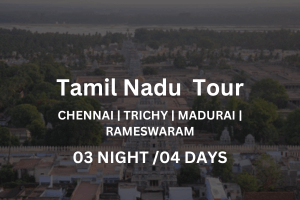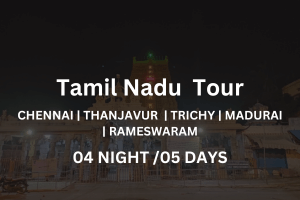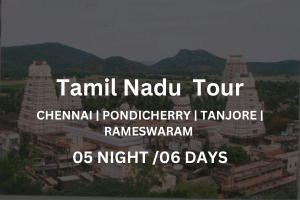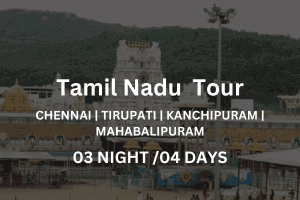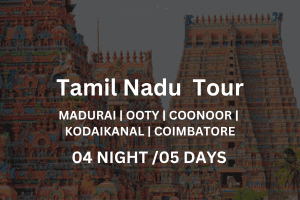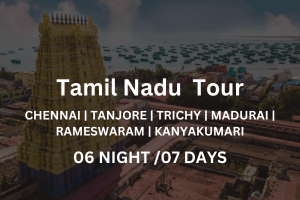Country : India State : Tamil Nadu
Minimum Tour Duration : 03 Nights / 04 Days
Maximum Tour Duration : 05 Nights / 06 Days
Ideal Tour Duration : 04 Nights / 05 Days
Best Time To Visit : November to February
Top Tourist Attraction : Brihadeeswarar Temple in Thanjavur and the Meenakshi Temple in Madurai & Cool heights of Ooty and Kodaikanal, Beaches of Marina and Mahabalipuram
Best Tour Package in Tamilnadu | Tamil Nadu Tour Package 2024 | Tamil Nadu Tour Packages Itinerary
Tamil Nadu, located in the southern part of India, is a treasure trove of history, culture, and natural beauty. As you embark on your Tamil Nadu tour package, get ready for a captivating journey through the heart of this diverse state.
Tamil Nadu, often referred to as the “Land of Tamils,” boasts a rich cultural tapestry and a history that dates back centuries. This southern gem is a perfect destination for travelers seeking a blend of tradition and modernity.
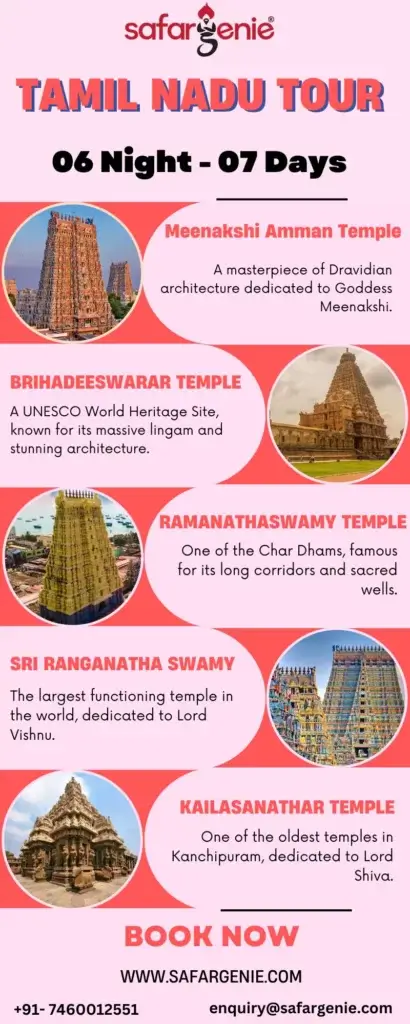
Exploring Tamil Nadu’s Rich Heritage
Historical Landmarks
From the ancient temples of Mahabalipuram to the grandeur of the Madurai Meenakshi Temple, Tamil Nadu is a living testament to its glorious past.
Cultural Festivals
Immerse yourself in the vibrant celebrations of Pongal and witness the grandeur of classical dance performances during the Natyanjali Dance Festival.
Picturesque Natural Beauty
Best Hill Stations in Tamil Nadu
Escape to the cool heights of Ooty and Kodaikanal, where rolling hills and tea plantations create a serene landscape.
- Ooty
- Yelagiri
- Kodaikanal
- Yercaud
Best Beaches in Tamil Nadu
Discover the pristine beaches of Marina and Mahabalipuram, offering a perfect blend of relaxation and cultural exploration.
- Kanyakumari Beach
- Mahabalipuram Beach
- Marina Beach
- Covelong Beach
The Spiritual Trail
Famous Temples
Tamil Nadu is home to some of the most revered temples, including the Brihadeeswarar Temple in Thanjavur and the Meenakshi Temple in Madurai.
20 Famous Temples of Tamil Nadu, South India
- Meenakshi Amman Temple, Madurai: A masterpiece of Dravidian architecture dedicated to Goddess Meenakshi.
- Brihadeeswarar Temple, Thanjavur: A UNESCO World Heritage Site, known for its massive lingam and stunning architecture.
- Ramanathaswamy Temple, Rameswaram: One of the Char Dhams, famous for its long corridors and sacred wells.
- Kapaleeshwarar Temple, Chennai: Dedicated to Lord Shiva, renowned for its vibrant architecture and the Arubathimoovar festival.
- Ekambareswarar Temple, Kanchipuram: One of the Pancha Bootha Sthalas, representing the Earth element.
- Sri Ranganatha Swamy Temple, Srirangam: The largest functioning temple in the world, dedicated to Lord Vishnu.
- Jambukeswarar Temple, Thiruvanaikaval: Known for its unique water tank and the annual float festival.
- Kumari Amman Temple, Kanyakumari: Located at the southernmost tip of India, dedicated to the virgin goddess Kanyakumari.
- Chidambaram Nataraja Temple, Chidambaram: A significant pilgrimage site for followers of Lord Shiva, showcasing the cosmic dance of Nataraja.
- Sri Rajagopala Swamy Temple, Mannargudi – Lord Krishna’s Grand Abode
- Kailasanathar Temple, Kanchipuram: One of the oldest temples in Kanchipuram, dedicated to Lord Shiva.
- Bala Murugan Temple, Siruvapuri
- Sripuram Golden Temple, Vellore – Solace and Eternal Peace
- Annamalaiyar Temple, Tiruvannamalai – Grandeur of Annamalai Hills
- Srivilliputhur Andal Temple – Virudhunagar – Divine Love and Eternal Grace
- Nagaraja Temple, Nagercoil – Legend of Naga
- Monolithic Rock Temples, Mahabalipuram
- Adi Kumbeswarar Temple, Kumbakonam
- Papanasam Temple, Tirunelveli
- Srivilliputhur Andal Temple – Virudhunagar

In Details 20 Famous Temples of Tamil Nadu, South India
Dedicated to the divine embodiment of Goddess Parvati, known as Meenakshi, and her consort, Lord Shiva, in the form of Lord Sundareswarar, the Meenakshi Amman Temple stands as an ancient marvel, renowned not only in Tamil Nadu but across the entirety of India.
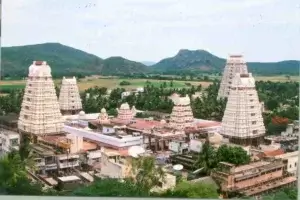
As per historical and archaeological records, the temple’s inception traces back to the 6th century AD, with a significant portion falling victim to the ravages of 14th-century Muslim invaders in India. The current structural magnificence, however, harks back to the 16th century, meticulously restored to its former glory under the patronage of the Nayak rulers.
Let’s delve into the Architectural Splendor This temple stands as a testament to the prowess of Dravidian architecture. The exquisitely sculpted and adorned ‘Gopurams’ stand as the prime spectacle, visible even from a considerable distance. Embellished with myriad depictions of gods, goddesses, and demons, the Meenakshi Amman Temple emerges as an architectural masterpiece.
Noteworthy Features Within the halls, intricately carved figures and scenes from Indian mythology contribute to the artistic allure of the temple. Instances such as the churning of the ocean of milk by devas and asuras, the melodious play of Ravana on his veena with nine heads, Rishi Markandeya embracing the Shiva Lingam, and the nuptial ceremony of Sundareswarar and Meenakshi stand out among the sculptures adorning the temple premises.
Celebratory Spectacle Presently, the temple witnesses a steady influx of devotees and tourists daily, swelling to a staggering one million during the annual Meenakshi Thirukalyanam festival, celebrated in the months of April-May.
2- Brihadeeswarar Temple, Thanjavur
The ‘Brihadeeswarar Temple’ stands as a captivating sanctuary dedicated to Lord Shiva, situated in the Thanjavur district of Tamil Nadu. It ranks among the largest temples in India, an exquisite manifestation crafted by the Chola dynasty in the 11th century AD, serving as an enduring symbol of the splendor and magnificence of the Chola rulers.
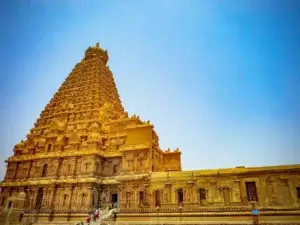
At present, this architectural marvel holds the prestigious designation of a UNESCO World Heritage Site, specifically listed under the ‘Great Living Chola Temples.’ It draws the reverence of hundreds of thousands of devotees and tourists annually.
Architectural Grandeur The temple’s towering structure, reaching a remarkable 216 feet, claims the title of the world’s tallest temple tower. The ‘Kumbam,’ the apex structure crowning the Vimana, weighs a staggering 80 tonnes, intricately carved from a single block of granite, further enhancing the overall magnificence.
Moreover, the Brihadeeswarar Temple boasts the unique distinction of being the world’s inaugural temple entirely constructed from granite. A notable feat, considering the absence of a granite quarry within a 100 km radius, prompts contemplation about the logistical marvels and tremendous efforts involved in transporting tons of granite to this sacred site.
Envision the Feat! Beyond transportation challenges, contemplate the meticulous process of carving such a colossal rock, given that granite is among the most formidable stones to cut. Imagine the complexities involved in embellishing it atop a Vimana towering 216 feet, all transpiring during an era when technology was in its nascent stages.
Temple Operating Hours – 6:00 am to 12:30 pm and 4:00 to 8:30 pm
3- Ramanathaswamy Temple, Rameswaram
As one of the pivotal pilgrimage sites, part of the revered ‘Char Dhams’ for Hindus globally, the ‘Ramanathaswamy Temple’ witnesses a constant influx of devotees. Beyond its status as a sacred ‘Chardham,’ the temple holds a distinguished place among the 12 revered Jyotirlingas of Lord Shiva.
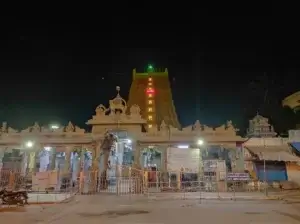
Mythical Narratives Legend intertwines with the Shivling enshrined in the temple’s main sanctum, tracing its origins back to the times of the Ramayana. Following his return from Lanka, Lord Rama, seeking absolution for slaying the scholar-demon Ravana, engaged in worship to Lord Shiva. Faced with a delay in acquiring the Shivling from the Himalayas, Lord Rama’s consort, Goddess Sita, crafted a Shivling from sand.
The resultant ‘Ramalinga’ has since resided in the sanctum of the Ramanathaswamy Temple for centuries. Adjacent to the Ramalinga is the ‘Viswalingam,’ the Shivling brought by Hanuman. Legend dictates that Lord Rama, observing Hanuman’s disappointment, decreed that successful completion of the sacred Yatra in Rameswaram is contingent on first paying homage to the Viswalinga. Consequently, rituals commence at the Viswalingam before proceeding to the Ramalinga.
Enchanting Architecture Nestled on the tranquil island of Rameswaram in Tamil Nadu, the temple’s construction is attributed to the Pandya rulers during the 12th century CE. The tallest among its four Gopurams reaches an impressive height of 126 feet, crafted in the distinctive Dravidian style.
The temple boasts India’s lengthiest corridor hall, composed of nearly 1000 intricately carved granite pillars. An imposing 6-meter tall Nandi statue further captivates visitors.
A pilgrimage to the Ramanathaswamy Temple not only imparts a profound spiritual journey but also unveils the grandeur and opulence of bygone eras.
Temple Operating Hours – 5:00 am to 1:00 pm and 3:00 pm to 9:00 pm.
4- Kapaleeshwarar Temple, Chennai
Nestled in the Mylapore district of Chennai, the ‘Kapaleeshwarar Temple’ traces its origins to the 7th century CE, built under the reign of the Pallava Kings. However, the present temple structure, standing tall today, harks back to the 16th century CE. The original edifice succumbed to the ravages inflicted by the Portuguese, and it was in the 16th century that the Vijayanagara Kings meticulously restored the temple to its former glory.
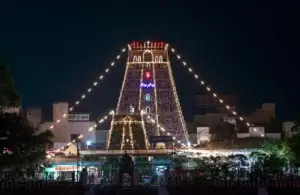
Vibrant Pillars of the Rainbow Dedicated to Lord Shiva, venerated in the form of Kapaleeshwarar, the temple holds profound significance among Tamil Nadu’s Shaivites, drawing a multitude of devotees daily. With a magnificent rainbow-colored Gopuram, pillared halls, and a water feature, the Kapaleeshwarar Temple exemplifies the authentic Dravidian style of architecture.
A Tale of Yore According to mythological narratives, Goddess Parvati, embodied as a peahen or ‘Mayil’ in Tamil, undertook extensive penance for Lord Shiva at this sacred locale. Consequently, a small shrine dedicated to Goddess Parvati, revered as Karpagambal, graces the temple complex alongside the main sanctum of Lord Shiva, enshrined in the form of a Shivling.
The Karpagambal shrine garners substantial crowds, particularly on Fridays, adorning the presiding deity with a resplendent garland of gold coins. Noteworthy within the temple is a small shrine beneath the venerable Punnai Tree in the courtyard, narrating the tale of Goddess Parvati, in peahen form, worshipping the Shivling.
A Revered Sanctuary in Tamil Nadu, a sojourn here promises an unparalleled experience of tranquility and divine connection.
5- Ekambareswarar Temple, Kanchipuram
Drawing legions of pilgrims and tourists from various corners of India and beyond, the ‘Ekambareswarar Temple’ holds a revered status among the five ‘Panch Bootha Sthalas,’ dedicated to the element of Earth. This sacred site carries profound religious significance for followers of Lord Shiva.
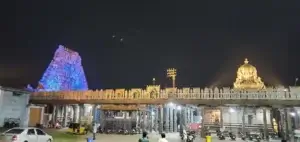
Goddess Parvati’s Devotion According to mythological lore, Goddess Parvati engaged in penance beneath a sacred mango tree at this site, fashioning a Shivling from sand for Lord Shiva. Pleased with her unwavering devotion, Shiva manifested before her and became known as Ekambareswarar, the ‘Lord of the Mango Tree.’
Architectural Marvel While the temple’s roots are traced back to 600 AD, the current structure is believed to date back to the 11th-12th centuries. The architecture reflects a distinctive Shaivite design, featuring an imposing Gopuram and five concentric circumambulatory enclosures. The Vijayanagara kings are credited with adding the 1000-pillared hall, adorned with carvings of 1008 Shiva Lingams, during the 15th century. The inner sanctum cradles the Prithvi Lingam.
Hallowed Foliage Within the temple precincts stands a sacred mango tree, reputed to be over 3000 years old. The uniqueness of this tree lies in its capacity to bear four distinct types of mangoes throughout the four seasons of the year.
For those embarking on a pilgrimage in South India, a sojourn to the Ekambareswarar Temple promises an enriching spiritual experience.
Temple Operating Hours – 6:00 am to 12:30 pm and 4:00 pm to 8:30 pm.
6- Sri Ranganathaswamy Temple, Srirangam
Dedicated to Lord Vishnu, the ‘Ranganathaswamy Temple,’ situated on Srirangam Island in the city of Tiruchirappalli, Tamil Nadu, stands as another marvel of Dravidian architecture. Encompassing an expansive area of over 150 acres, the temple boasts 49 sub-shrines and is adorned with 21 intricately carved Gopurams (tower gateways), with the principal ‘RajaGopuram’ soaring to an impressive height of 236 ft., making it the tallest Gopuram in Asia.

Temple Township This unique shrine stands as the only one of its kind where a harmonious blend of a temple and township coexists. A segment of the temple is devoted to religious activities, while the remainder serves as a township for human habitation.
The temple features 7 prakaras or enclosures, with the presiding deity Lord Vishnu, in the form of Lord Ranganathaswamy reclining on a five-headed serpent, enshrined in the innermost prakara. The tower above the innermost prakara takes the shape of ‘Om’ and is entirely plated in Gold.
Counted as the foremost among the 108 ‘Divya Desams’ or holy abodes of Lord Vishnu, the temple attracts countless pilgrims and tourists annually.
Let’s Revive the History While the exact consecration date remains elusive, archaeological records trace the original temple structure back to the 10th century during the rule of the Chola dynasty. In the 14th century, the temple faced wealth plundering by Muslim invaders and was subsequently restored to its former grandeur by the Vijayanagara and Nayaka rulers in the late 16th century.
What’s in it for you? Soulful Architecture: The temple’s magnificent architecture, intricate carvings, exquisite sculptures, and vibrant frescoes provide a profound glimpse into the exceptional skills of the architects, sculptors, and artisans of that era. Artistic and Sublime Views: A visit to the temple must include the thousand-pillared hall, a testament to artistic brilliance. The exquisitely carved figures of horses standing on their rear legs, depicting war scenes on the base of these pillars, offer a true spectacle.
Temple Operating Hours – 6:00 am to 12:00 pm and 6:00 pm to 9:00 pm.
7- Jambukeswarar Temple, Thiruvanaikaval
On the Srirangam Island of Tamil Nadu stands the ‘Jambukeshwara Temple,’ a dedicated abode to Lord Shiva. Constructed during the Chola period, this temple stands as a splendid testament to the Dravidian style of architecture. Its 7-tiered Gopuram, adorned with intricate carvings, showcases the artistic opulence of the Chola Kingdom.
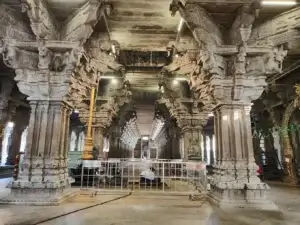
The Shiva Lingam takes the form of the Appu Lingam (water lingam), and beneath it flows an underground stream, continuously streaming water.
Myths of Significance According to mythological tales, Goddess Parvati, in the guise of Akilandeswari, undertook profound penance beneath the ‘Jambu Tree,’ believed to have sprouted from the head of a meditating saint. To conduct the Pooja, she fashioned a lingam from the waters of the River Cauvery. Touched by Parvati’s devotion, Shiva granted her darshans and imparted Shiva Gnana.
Enacting the Traditions Reenacting Parvati’s penance as Akilandeswari worshipping Lord Shiva, each day at noon, the temple priest, attired as a female in a saree, offers prayers to Lord Jambukeswarar. This noon ritual draws hundreds of devotees daily, offering a unique glimpse into some of India’s distinctive traditions and customs, particularly for those visiting India for the first time.
Temple Operating Hours – 6:00 am to 1:00 pm and 4:00 pm to 9:30 pm.
8- Kumari Amman Temple, Kanyakumari
On the Kanyakumari peninsula in Tamil Nadu stands the ‘Kumari Amman Temple,’ devoted to the virgin Goddess Kanya Kumari, an incarnation of Goddess Shakti. Dating back 3000 years, the temple graces the tranquil confluence of the Arabian Sea, Indian Ocean, and Bay of Bengal. The idol of the presiding deity portrays a charming young girl holding a rosary in her right hand.
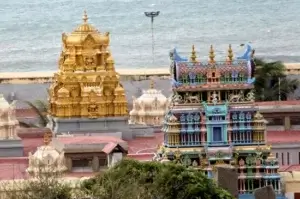
Let’s travel back in time Mythologically, during Puranic times, the demon king Banasura secured a boon from Lord Shiva that he could only be defeated by a virgin. Exploiting this boon, he inflicted great torment upon the Devas, prompting them to seek relief from the harassment through worship of Goddess Parvati. Responding to their pleas, Goddess Parvati manifested as a young girl and undertook penance for Lord Shiva at the confluence of the three oceans to vanquish Banasura.
Enchanted by Kanya Kumari’s beauty, Banasura attempted to coerce her into marriage, leading to a fierce battle resulting in his demise. Relieved of Banasura’s atrocities, Lord Parshuram constructed a temple dedicated to Devi Kanya Kumari. The deity’s idol is believed to be the same one installed by Parshuram.
The nose ring worn by the deity has its own tale; it is said that the diamonds on the nose ring shine so brightly that, in the past, some ships at sea mistook the brilliance for a lighthouse, leading to shipwrecks on nearby rocks. Following these incidents, the eastern door (facing the sea) of the temple remains closed.
One of Tamil Nadu’s renowned pilgrimage destinations, a visit to this temple is certain to bestow blessings of peace and prosperity.
Temple Operating Hours – 4:30 am to 12:30 pm and 4:00 pm to 8:00 pm.
9–Chidambaram Nataraja Temple, Chidambaram
Dedicated to Lord Shiva in the form of Nataraja, the cosmic dancer, the ‘Thillai Nataraja Temple’ stands as one of Tamil Nadu’s most ancient temples, renowned for its religious and architectural significance.
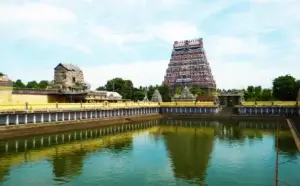
Panchabhuta Believed to have been constructed during the Pallava rule in the 11th century, the temple underwent subsequent renovations during the reigns of the Cholas, Pandyas, and Vijayanagara. The Nataraja Temple holds the distinction of being one of the ‘Panchabhuta Sthalas,’ with each element of the universe—earth, air, water, fire, and space—represented. This temple symbolizes the fifth element, space.
What’s in it for you? The temple’s location is said to be the center of the Earth’s magnetic field. The primary sanctum, known as Chitsabha, enshrines the deities Nataraja and Sivakamasundri (Nataraja’s consort). The Chitsabha’s roof, crafted from gold, is believed to have been erected during the Chola rule. The temple includes a shrine for Sivakamasundri, known as the Sivakami Amman Temple, and a 1000-pillared hall designed in the form of a chariot. Dating back to the Chola period, both the temple and the hall are adorned with depictions of dancers, drummers, and musicians on the walls. The temple’s lofty gopurams, adorned with carvings of Hindu gods, various manifestations of Lord Shiva, and dancers representing 108 postures of Bharatnatyam, are a mesmerizing sight. One of the most significant temples for Shaivites, a visit here is certain to bestow inner peace and solace.
Temple Operating Hours – 6:00 a.m. to 12:30 p.m. and from 4:30 p.m. to 10:00 p.m.
10- Sri Rajagopala Swamy Temple, Mannargudi
Located in the town of Mannargudi, the divine temple of Rajagopala Swamy stands as one of the most revered shrines dedicated to Lord Krishna. Also known as Guruvayoor by Hindus, it holds a significant place among the popular Vaishnavite temples in India.
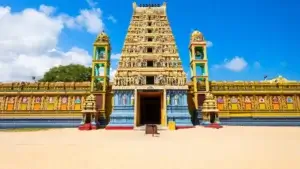
What’s the Appeal? The temple boasts mesmerizing stone inscriptions, a 154ft gateway tower known as Rajagopuram, and the largest temple tank, Haridra Nadhi. These features provide a tranquil ambiance, offering a rejuvenating experience for the soul, coupled with mind-boggling views for a visual treat.
Famous Festival The most renowned festival of the Sri Rajagopala Swamy Temple is the Chariot Festival, held in the month of June-July.
In the Legends- Reason behind the Tusk in the left hand of Lord Krishna According to a legend, Lord Krishna slew a wild elephant named Kuvalaya Peetam, who was actually Kansa (Lord Krishna’s maternal Uncle). Kansa aimed to kill Lord Krishna’s elder brother Balrama in the form of an elephant. However, Lord Krishna preemptively killed the wild elephant and held one enlarged tusk in his left hand.
Another Legend The main sanctum of the temple showcases 32 forms of Lord Krishna. According to legend, Lord Krishna manifested in 32 forms to give darshan to two sages, Paravasudeva and Raja Gopalan.
Temple Operating Hours – 6:30 am to 12:00 pm and 4:30 pm to 9:00 pm.
11- Kailasanathar Temple, Kanchipuram
Kanchipuram, the ancient town of Tamil Nadu, has been captivating divinely inspired travelers with its divine allure, where temples narrate mystic tales of gods, showcasing the grandeur and artistic brilliance of the Pallava Dynasty. Exploring this fascinating wonder will etch the city’s Dravidian heritage and glorious past into your soul. Among the notable temples from the Pallava period, two prominent ones in Kanchipuram are:
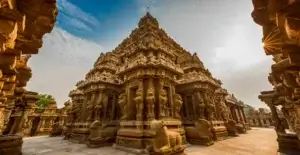
Kanchi Kailasanathar Temple Located in the Kanchipuram district of Tamil Nadu, the ‘Kanchi Kailasanathar Temple’ stands as one of the most renowned pilgrim centers in South India. Dating back to the late 7th century-early 8th century, the temple is believed to have been constructed during the reign of the Pallava Dynasty.
Artistic Architecture Carved entirely out of sandstone, the temple is the oldest in Tamil Nadu dedicated to Lord Shiva. The main sanctum houses a 16-sided Shivling made of black granite. The temple’s architecture showcases a brilliant Dravidian style, featuring a delicately carved pyramidal-shaped tower on the main sanctum and 58 small Shiva shrines enclosed within the complex.
Major Highlights Prominent highlights include exquisitely carved sculptures of Lord Shiva and his consort, Goddess Parvati, depicted in various dance postures adorning the inner walls. Standing tall as a symbol of the grandeur of the Pallava kings, the ‘Kanchi Kailasanathar Temple’ attracts pilgrims from across the country, especially during Maha Shivratri, when devotees throng to seek the blessings of the God.
12- Bala Murugan Temple, Siruvapuri
Dating back 500 years, the ‘Bala Murugan Temple’ is devoted to Lord Murugan, also known as Kartikeya, the son of Lord Shiva and Goddess Parvati. The temple is believed to be a sacred place where Lord Murugan fulfills the wishes of his true devotees, drawing hundreds of people every day. It holds a special significance for those seeking blessings for a new house or property.
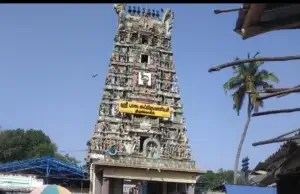
Beliefs The presiding deity of the temple is a 4.5 feet tall idol of Lord Murugan. Outside the sanctum sanctorum, a sculpture of a peacock made with green emerald is considered religiously significant.
A shrine within the temple complex, dedicated to Lord Murugan and his consort, Devi Valli, portrayed in wedlock, is frequented by devotees seeking marital bliss. Praying here on the day of the Poosam star is believed to be highly auspicious and fulfills the wish for marriage for both boys and girls.
One of the very popular holy shrines in Tamil Nadu, a visit to this temple offers a unique experience and spiritual bliss.
Temple Timings: 7:00 am to 12:00 pm and 4:30 pm to 8:00 pm.
13- Sripuram Golden Temple, Vellore – Solace and Eternal Peace
Situated on the hills of Malaikodi in the city of Vellore, Tamil Nadu, the ‘Sripuram Golden Temple’ has become a must-visit destination for tourists exploring temples in South India. Despite being a recent addition, built in 2007, the temple stands tall in stunning beauty and grandeur, dedicated to Goddess Lakshmi, also known as ‘Sri Lakshmi Narayani’—the Goddess of wealth and prosperity.
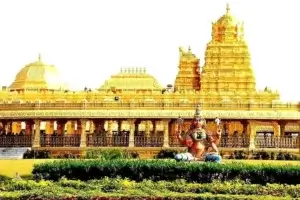
Temple of Fascinating Beauty The temple showcases astounding carvings, sculptures, artwork, and exquisite lighting on its walls, ceiling, and pillars, leaving visitors awestruck. The glittering reflection of the temple in the surrounding water body at night is beyond words, enchanting observers with its hypnotizing beauty.
What’s in it for you? The pathways leading to the main temple are designed in the shape of a star, each adorned with messages from the Gita, Bible, and Quran. As you traverse these pathways, absorbing the essence of these messages, you gain deep wisdom and knowledge.
Crossing the pathways and pillared halls, devotees behold the darshans of Maha Lakshmi enshrined in the inner sanctum. Astonishingly, the deity of Maha Lakshmi is crafted from 70 kilograms of gold.
Temple Timings: 9:00 am to 7:00 pm.
14- Annamalaiyar Temple, Tiruvannamalai – Grandeur of Annamalai Hills
Another significant temple among the ‘Panchabhuta Sthalas,’ the ‘Annamalaiyar Temple’ symbolizes the element of fire, with Lord Shiva revered here in the form of Agni Lingam. The temple’s structure dates back to the 9th century during the Chola dynasty’s rule in South India. Further enhancements were made by the Vijayanagara kings in the 15th century.
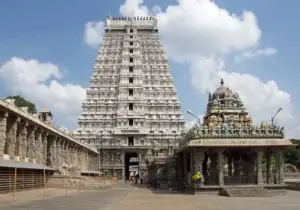
Architectural Marvel Situated at the foot of Annamalai hills, the temple sprawls across 25 acres and boasts typical Dravidian architectural style. The Rajagopuram, standing at a towering 217 feet, is a testament to the artistic brilliance of Vijayanagara artisans. The 11-tiered gopuram, adorned with intricate carvings, is visible from a considerable distance. Inside the temple complex, six concentric enclosures house shrines of various deities, with the innermost enclosure containing the sanctum housing the Agni Lingam.
Popular Festival The temple, always bustling with devotees from around the world, experiences a significant surge during the annual ‘Karthigai Deepam Festival.’ Marked by grand processions featuring drummers, dancers, and vibrant attire, this festival offers a colorful spectacle and provides insight into the diverse rituals and customs of South Indian temple festivals.
Temple Timings: 5:30 am to 12:30 pm and 3:30 pm to 9:30 pm.
15- Srivilliputhur Andal Temple – Virudhunagar – Divine Love and Eternal Grace
Srivilliputhur Andal Temple stands as one of the most revered shrines dedicated to Lord Vishnu, with its divine roots tracing back to the 8th century BC. King Villi, guided by a divine vision of Lord Vishnu in his dreams, undertook the construction of this sacred temple. The temple’s significance is intertwined with the legendary tales of two saints, Periyalwar and Andal.
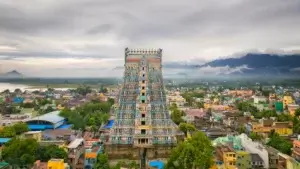
Interesting Legend According to the legends, Andal, an incarnation of Goddess Earth (Bhoodevi), was discovered at the age of five in the temple garden, Nandanavanam, by Periyalwar. Since Periyalwar had no children, he adopted Andal. A unique episode unfolded when Andal, without Periyalwar’s knowledge, wore a garland intended for Lord Vadabadrasayee and later placed it back in the flower basket. Unaware of this, Periyalwar continued offering the garland to Lord Vadabadrasayee. When Periyalwar discovered Andal’s act, he was upset. However, Lord Vadabadrasayee appeared in Periyalwar’s dreams, expressing a preference for Andal’s garland, and since then, only Andal’s garland is offered to the deity.
Center of Attraction This temple boasts the largest gopuram in Tamil Nadu, serving as the emblem of the Tamil Nadu Government. The shrine of Lord Vatapatrasayi (Vishnu) is situated in the northeast direction, while Goddess Andal’s (Laxmi) shrine is in the southwest direction. The festival of Aadippoorem, celebrating Andal’s birthday, is a widely popular event held in July-August, drawing devotees from around the world to seek divine blessings and experience solace.
Temple Timings: 4:00 am to 1:00 pm and 4:00 pm to 8:30 pm.
16- Nagaraja Temple, Nagercoil – Legend of Naga
Nagaraja Temple in Nagercoil: A Serene Abode Dedicated to Vasuki, the Serpent King
Nestled in the town of Nagercoil, within the Kanyakumari district of Tamil Nadu, the Nagaraja Temple stands as a devoted sanctuary to Vasuki, the serpent king. The primary deity of this temple is the five-headed Naga God, attracting numerous devotees, especially during the Tamil month of Avani (August and September). A special Pooja is conducted on Sundays, involving offerings of milk and turmeric to the deity.
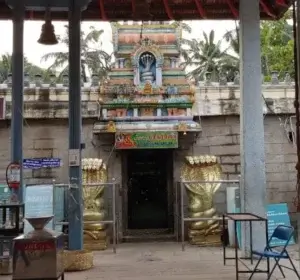
Highlights: The temple witnesses a substantial influx of individuals grappling with Naga Dosha during the Tamil month of Avani, marked by unique rituals performed over 12 days.
Delightful Legends of Significance: According to local folklore, a village girl, while cutting grass in the vicinity, discovered blood oozing from her axe upon accidentally striking a stone. Recognizing the stone as an idol of a five-headed snake, villagers built the Nagaraja Temple with mud walls and a roof made of coconut leaves. The main sanctum retains these mud walls and thatched roof, with the stone idol of Nagaraja placed on the soil. The soil underneath the idol is believed to exude blood continuously, possessing healing properties for skin ailments. Visitors receive this soil as prasadam.
Temple Architecture: The temple’s architecture is simple, adorned with numerous sculptures and images of various snakes on the walls, trees, and surrounding pond. The main sanctum houses the deity, guarded by two imposing statues of five-headed serpents. Within the temple grounds, one can find a Shivling and an idol of Vishnu in the Anant Shayana position.
A unique and tranquil temple, set amidst serene surroundings, a visit to the Nagaraja Temple promises a blissful experience.
Temple Timings: 5:00 am to 11:30 am and 5:00 pm to 8:00 pm.
17- Monolithic Rock Temples, Mahabalipuram
Mahabalipuram: A Glimpse into Ancient Marvels
Known as the ancient temple town, Mahabalipuram stands as a UNESCO World Heritage site, tracing its origins to the 7th century during the Pallava dynasty’s rule. This town serves as a testament to some of India’s most remarkable architectural and sculptural accomplishments.
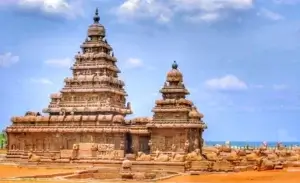
Major Highlights: The focal point of Mahabalipuram is the collection of five monolithic rock-cut temples known as ‘Pancha Rathas’ or chariots. Each ratha is believed to be dedicated to one of the Pandava brothers from the Mahabharata. Carved in distinct shapes and sizes, adorned with captivating sculptures of animals, humans, and gods, these structures showcase the exceptional architectural skills of Pallava sculptors.
Another prominent attraction is the exquisite ‘Shore Temple,’ unlike other temples in the region, built from granite blocks. It stands as an early example of stone-built temples in South India. The inner sanctum houses a Shivling, while a shrine dedicated to Lord Vishnu, depicting him reclining on the Sheshnag, adorns the inner walls. The outer courtyard is adorned with multiple sculptures of the Nandi bull. Overlooking the Bay of Bengal, this temple not only reflects the artistic brilliance of artisans but also the royal taste of Pallava kings.
A visit to Mahabalipuram is incomplete without marveling at its gigantic bas-relief works carved from granite blocks dating back to the 7th century. Notable among them is the depiction of the descent of the River Ganges, with Lord Shiva shown cradling her in his matted locks. Another striking relief work is ‘Arjuna’s Penance,’ portraying Arjuna undertaking penance to obtain a powerful weapon from Lord Shiva, crucial for the Pandavas’ victory over the Kauravas in the Mahabharata battle.
Temple Timings: 6:00 am to 6:00 pm.
18- Adi Kumbeswarar Temple, Kumbakonam
Adi Kumbeswarar Temple: A Timeless Marvel of the Chola Dynasty
The majestic legacy of the Chola dynasty endures in the divine Adi Kumbeswarar Temple, an exquisite masterpiece in the Dravidian style. Renovated by Govinda Dikshitar, chief of Achutha Nayakar of Thanjavur in the 16th century AD, this temple is a dedicated abode to Lord Shiva.
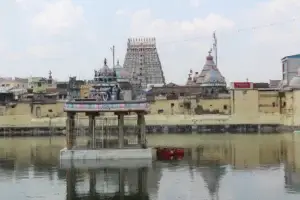
Holy Domain to Embrace the Ethereal: Recognized as the 26th Paadal Petra Sthalam during the Chola Period, the Adi Kumbeswarar Temple draws devotees worldwide. During the Mahamaham festival, celebrated once every 12 years (resembling the Kumbh Mela in the North), devotees converge to take a ritual bath in the Potramarai tank.
The divine Shiva Lingam within the temple captivates hearts, shaped like a needle at the top and broadening at the bottom. Alongside Kumbeswarar, his consort, Goddess Mangalambika, bestows her divine blessings upon the devotees. Additionally, the temple premises house shrines dedicated to Lord Murugan, Lord Ganesha, Lord Kiratamurati, and others.
Divine Myths: In a mythical narrative, as the curtain of life on the world was threatened by a tsunami, Lord Brahma sought guidance from Lord Shiva on where to commence the creation of mankind. Lord Shiva proposed the collection of sand from sacred places, placing it in a magic pot, and leaving it in the water. The pot, located where the grand temple of Kumbeswarar stands today, became the epicenter of the creation. An arrow shot by Lord Shiva caused nectar mixed with sand to spread in all directions, forming the Linga known as Kumbeswarar.
Temple Timings: 6:00 am – 12:30 pm and 4:00 pm – 9:30 pm.
19. Papanasam Temple, Tirunelveli
Papanasam Temple: A Divine Haven Dedicated to Lord Shiva
The divine temple of Papanasam in Tirunelveli is a sacred abode dedicated to Lord Shiva, its origins veiled in the mists of time. Legend has it that Lord Shiva, positioned between the horns of Nandi, bestowed his divine darshan upon the sage Patanjali and Vyaghrapada at the very location where this venerable temple stands today.
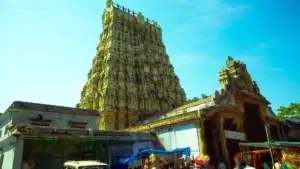
Another tale narrates how Lord Indra, incurring the sin of Brahmahathi Dosha for slaying the son of Venus, sought redemption by worshipping Lord Shiva. Legend places this divine episode at Papanasam, where Lord Indra, upon entering its borders, cleansed himself of the sin. Pilgrims from across the globe converge here to seek atonement for their sins and receive the divine blessings of Lord Shiva.
Popular Festivals: Experience the spiritual fervor during the Brahmotsavam Festival (April-May) and Thaipoosam (January-February), where devotees partake in the joyous celebrations.
Major Highlights: -The picturesque River Tambiraparani, flowing from the Pothigai Hills, adds to the enchantment of this sacred site. -Breathtaking views of dams, water bodies, the Agastyar waterfall, and the mountain range enhance the serenity of this hallowed place. -Explore the Kalakad Mundanthurai Tiger Reserve, an exquisite destination nestled in the embrace of nature.
Temple Timings: 6:30 am to 1:00 pm and 4:30 pm to 8:00 pm.
20-Srivilliputhur Andal Temple – Virudhunagar
Srivilliputhur Andal Temple: A Sacred Haven for Lord Vishnu’s Devotees
The Srivilliputhur Andal Temple stands as a revered sanctuary dedicated to Lord Vishnu, its divine roots tracing back to the 8th century BC. The visionary King Villi, guided by dreams of Lord Vishnu, undertook the noble task of constructing this sacred haven as a testament to his divine visions.
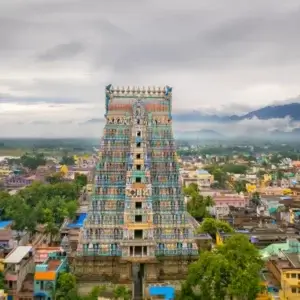
Interesting Legend: Legends intertwine with the tale of two saints, Periyalwar and Andal, adding a layer of mysticism to this holy site. Andal, an incarnation of Goddess Earth (Bhoodevi), was discovered at the tender age of 5 in the temple garden of Nandanavanam by Periyalwar. As he had no offspring, Periyalwar adopted Andal. A captivating episode unfolded when Andal, in a moment of innocence, wore a garland intended for Lord Vadabadrasayee, then subtly replaced it in the flower basket. Unaware, Periyalwar continued offering this garland to Lord Vadabadrasayee until the divine revelation in his dreams. Lord Vadabadrasayee conveyed that only Andal’s garland would be accepted henceforth, cementing the sacred connection between Andal and the deity.
Center of Attraction: -The temple boasts the largest gopuram in Tamil Nadu, also serving as the emblem for the Tamil Nadu Government. -The shrine of Lord Vatapatrasayi (Vishnu) graces the Northeast direction of the temple, while the divine abode of Goddess Andal (Laxmi) resides in the Southwest direction. -Aadippoorem, the grand festival celebrating Andal’s birthday in July-August, draws devotees worldwide seeking the divine blessings of Lord Vishnu and Andal.
Temple Timings: 4:00 am to 1:00 pm and 4:00 pm to 8:30 pm.
Religious Significance
Uncover the spiritual significance behind each temple, steeped in mythology and devotion.
Culinary Delights of Tamil Nadu | Famous Food in Tamil Nadu
Unique Dishes
Indulge in the flavors of Chettinad cuisine and savor traditional dishes like dosa, idli, and filter coffee.
- Chicken Chettinad
- Payasam
- Filter Kaapi
- Sambar
- Puliyodarai
- Rasam
Street Food Experience
Explore the bustling streets for local delights like murukku and pani puri, offering a gastronomic adventure.
Traditional Arts and Crafts
Handicrafts
Witness the skilled craftsmanship in Tanjore paintings and traditional silk weaving.
Traditional Dance Forms
Experience the artistry of Bharatanatyam and other classical dance forms that showcase the cultural richness of Tamil Nadu.
Adventure and Wildlife
National Parks
For nature enthusiasts, visit Mudumalai National Park and Guindy National Park, where diverse flora and fauna await.
Adventure Activities
Engage in trekking in the Western Ghats or wildlife safaris, adding an adventurous twist to your tour.
Off the Beaten Path
Hidden Gems
Unearth lesser-known attractions like Hogenakkal Falls and the quaint village of Tharangambadi for a unique experience.
Lesser-Known Attractions
Discover the charm of Munnar’s tea gardens and the tranquility of Vattakottai Fort, offering a break from the tourist crowds.
Planning Your Tamil Nadu Tour
Best Time to Visit
Consider the seasons for a comfortable visit, with November to February being the most pleasant.
Geographically, Tamil Nadu cycles through summers, winters, and the monsoon season. Despite these discernible transitions, the state predominantly maintains a humid and arid climate for the major part of the year. A season-centric approach aids in determining the optimal time to explore the wonders of Tamil Nadu.
Summer
March to May marks the summer sojourn, enveloping the region in an oppressive heat, particularly in urban hubs like Chennai, Vellore, Madurai, and Thanjavur, where temperatures soar to 45 degrees Celsius. Paradoxically, this season unveils a silver lining for hill station enthusiasts. Ooty, Yercaud, Nilgiris, and Kodaikanal, along with cities westward like Theni, Salem, and Coimbatore, beckon with a breezy and pleasant respite.
Monsoon
June to September witnesses the monsoon’s artistic strokes across Tamil Nadu. Though temperatures dip slightly to a range of 25 to 30 degrees Celsius, the climate retains its warmth and humidity. Coastal escapades and hill station escapades are less recommended, as intermittent cyclones along the Eastern seaboard pose potential threats.
Winter
October to February unveils the winter canvas, adorned with temperatures ranging from 22 to 30 degrees Celsius. The weather is comfortably cool, accompanied by a pleasant breeze, ideal for unhurried sightseeing and city exploration. Beach destinations allure with their loveliness, and the water maintains a delightful temperature. This period is deemed the prime time to traverse Tamil Nadu, with a plethora of events and festivals dotting the landscape. From Pongal to the globally acclaimed Carnatic Music Festival, these festivities encapsulate the vibrant culture and traditions of Tamil Nadu, providing an unparalleled experience.
Travel Tips
Pack comfortable clothing, stay hydrated, and respect local customs for an enjoyable journey.
Accommodations
Options for All Budgets
Choose from luxury resorts to budget-friendly guesthouses, ensuring a comfortable stay.
Unique Stay Experiences
Opt for heritage stays or beachside cottages for a memorable and immersive experience.
Transportation | How to Reach Tamil Nadu
Getting Around Tamil Nadu
Explore the state using a well-connected network of buses, trains, and private cabs.
Public Transport Options
Experience the local culture by taking a ride on the colorful and bustling local buses.
Tamil Nadu stands intricately linked to the broader Indian landscape, boasting robust air and land connectivity. Herein lies a nuanced exploration of the prime avenues to embark on a journey to this exquisite locale.
By Air
Navigating the skies proves paramount, with Tamil Nadu hosting a constellation of nine airports, spanning both international and domestic domains. Chennai, the pulsating capital, proudly houses India’s fourth busiest aviation hub. Comprising three terminals, this airport orchestrates daily flights from major metropolises like Delhi, Mumbai, Bangalore, and Kolkata. Furthermore, it serves as a nexus for direct flights from cosmopolitan destinations, including Singapore, Dubai, London, Frankfurt, and Mauritius.
Embarking on Tamil Nadu’s tapestry often commences through Chennai, conveniently segueing into extensive road or rail exploration. A mere 21 kilometers (13 miles) from the city center, the airport stands as a gateway to the vibrant expanse.
By Railway
For the frugal explorer, the rail network unveils itself as an optimal choice. The state’s intricate web of Southern Railways intricately links key points, providing an economical sojourn. Chennai Central, colloquially acclaimed as the bustling heartbeat of Southern India’s rail network, orchestrates an influx of trains from every nook and cranny of the nation. Its strategic proximity to Chennai’s iconic landmarks, such as Marina Beach, Elliot’s Beach, Egmore, and Kapalesara, enhances the travel experience.
By Road
Tamil Nadu’s arterial road network, meticulously maintained, is a testament to its accessibility. National Highways weave a comprehensive tapestry, with the Tamil Nadu State Transport Corporation (TSTC) and State Express Transport Corporation steering the bus transportation realm. National Highways 67, 207, and 209 serve as conduits to Karnataka, while NH 47, 49, 208, and 220 establish links with Kerala. Meanwhile, NH 205, 219, and 234 forge connections with Andhra Pradesh.
A symphony of buses traverses the myriad attractions within Tamil Nadu, affording travelers the luxury of choice as they finalize their itinerary. This meticulous approach ensures a seamless and gratifying journey through the resplendent landscapes of Tamil Nadu.
Safety Tips for Tourists
Dos and Don’ts
Follow safety guidelines, avoid isolated areas at night, and be cautious with valuables.
Emergency Contacts
Keep essential numbers handy for a secure travel experience.
Local Etiquette
Cultural Norms
Respect local traditions, greet with a “Vanakkam,” and participate in cultural events with humility.
Respecting Traditions
Adhere to temple dress codes and be mindful of local customs to foster positive interactions.
Best Places to Visit in Tamil Nadu
- Nilgiris
- Auroville
- Hogenakkal Falls
- Mahabalipuram
- Kanyakumari
- Rameshwaram
- Mudumalai
- Chennai
- Pondicherry
- Coimbatore
- Madurai
- Nawaghare
- Tuticorin
- Kanchipuram
Sustainable Tourism
Eco-Friendly Initiatives
Support eco-friendly initiatives and choose responsible travel options for a sustainable tour.
Responsible Travel Tips
Minimize plastic usage, opt for eco-friendly accommodations, and respect wildlife habitats.
Conclusion
Embark on your Tamil Nadu tour with a sense of excitement and curiosity, for this state has much to offer beyond the ordinary. Whether you seek spiritual enlightenment, cultural immersion, or a rendezvous with nature, Tamil Nadu welcomes you with open arms.
Frequently Asked Questions (FAQs)
The period from November to February offers pleasant weather, making it ideal for travel.
Yes, Tamil Nadu provides a range of accommodations to suit all budgets, from luxury resorts to affordable guesthouses.
Venture off the beaten path by visiting lesser-known attractions like Hogenakkal Falls and Tharangambadi village.
Follow safety guidelines, avoid isolated areas at night, and be cautious with valuables for a secure travel experience.
Support eco-friendly initiatives, choose responsible travel options, and minimize your environmental impact.

